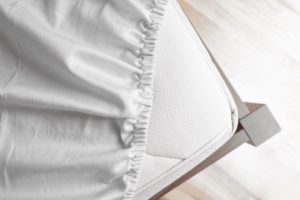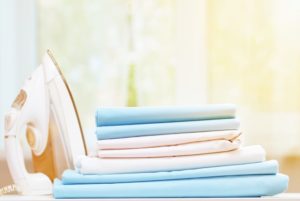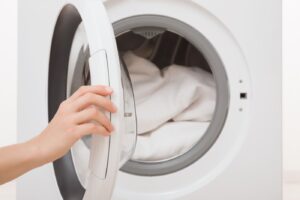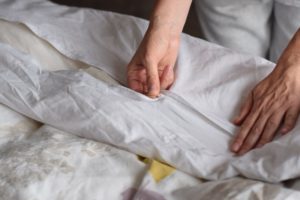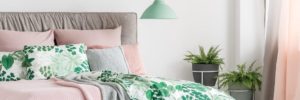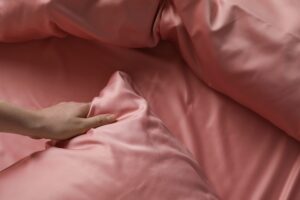How to Buy Sheets
- Understanding how to buy sheets that meet your needs can help you protect your mattress and get a good night’s sleep. We recommend buying sheets made from comfortable, high-quality materials. Also, consider higher thread counts for added softness and durability if your budget allows.
Buying sheets seems like a straightforward process until you search online and discover hundreds of options. With many materials, styles, and thread counts available, locating the ideal sheets for you and your bed can feel daunting. But because you sleep on them so frequently, it’s worth finding a comfortable set that will hold up through regular washings.
The best sheets for you will depend on your mattress, your personal preferences, and your budget. For example, certain options will work better for you than others if you sleep hot or cold, if you have a thick mattress, or if you want sheets that don’t wrinkle.
We’ll discuss how to buy sheets by walking you through sheet sizes and materials and discussing other important considerations, like pricing and durability.
How to Choose Sheets
Sheet preferences, just like mattress preferences, vary widely from person to person. With so many sizes, thread counts, and materials to choose from, it’s important for sleepers to understand their options and preferences before investing in sheets.
Bed Size
Mattresses come in six standard sizes. Sheet sets are designed to fit each mattress size, varying in length and width for proper mattress coverage. While some top sheets can work for multiple bed sizes, buying the right fitted sheet size is especially important because it fits tightly around the four corners of a mattress.
Manufacturers generally sell sets according to mattress size, but it’s still a good idea to cross-reference mattress measurements with the sheets’ dimensions to ensure an appropriate fit. This is especially true for mattresses thicker than 14 inches, which may require fitted sheets with deep or extra-deep pockets.
Sheet Sets vs. Individual Sheets
Sheets are sold both individually and in sets that include a fitted sheet, a flat sheet, and one or two pillowcases. Sets can be an affordable and convenient option to get everything you need in one package. However, if you like mixing and matching, or if you anticipate needing to replace one item in a set, you might consider buying sheets separately. Some people may also appreciate the option to buy a larger top sheet, especially if they share a bed with a partner.
What Is a Top Sheet?
A top sheet is another name for the flat sheet that serves as a barrier between you and your comforter or quilt. Top sheets keep outer bedding cleaner between washings and add a layer of light insulation. They also allow a bed to be made or turned down in aesthetically pleasing ways. However, using a top sheet could add time to your bed-making routine. You might also find that you get tangled in your top sheet if you move a lot during the night.
How Many Sheet Sets Are Necessary?
Most people prefer having at least two sets of sheets. While you wash one set, you can add the other to your bed. If you have enough storage space for extra sets, investing in three or four might be helpful. This is especially true if you change your sheets very often, which may be necessary if you sleep hot, live in a warm climate, or have kids or pets.
Hot vs. Cold Sleepers
Some people sleep hot, while others need extra blankets to keep warm. The best sheets for hot sleepers are made from breathable materials, like cotton, linen, or bamboo-derived fabrics. On the other hand, cold sleepers might need some extra warmth from thicker fabrics, like flannel, or tighter weaves, like twill.
Style Options
You can find bed sheets in an assortment of textures, colors, and patterns to fit your bedroom’s style. Be aware that even sheets of the same color can look very different depending on the material and weave. For example, linen sheets in beige have a rustic look, while beige cotton sheets with a sateen weave have an elegant sheen.
Cost
Sheets are sold at a wide range of prices. While some sheet sets cost less than $20, more luxurious sets can cost more than $200. The material, quality, and thread count of sheets all affect price. The size of the sheets also makes a difference, with smaller sizes costing less.
Quality
Prices and brand names aren’t the only indicators of quality sheets. Thread count is also an important consideration, with higher counts typically indicating better durability and comfort. Some sheet types, such as flannel and jersey, are more commonly labeled with a GSM measurement, which stands for grams per square meter. Generally, the higher the GSM rating, the heavier and warmer the fabric.
Thread Count
Thread count is the number of strands, both horizontal and vertical, that pass through a square inch of fabric. Sheets with higher thread counts are more tightly woven and generally have greater softness and durability than sheets with lower thread counts.
That said, thread count is not the be-all-end-all when it comes to the quality of sheets. Some weaves, like percale, by their nature have lower thread counts than other weaves, like sateen. Additionally, some manufacturers inflate the thread counts of sheets by using double- or triple-ply threads, so be suspicious of sheets marketed as having thread counts of 900 or more.
The ideal thread count range varies by fabric and weave:
- Linen: 80-140
- Cotton: 200-400
- Percale Weave: 200-400
- Egyptian Cotton: 300-400
- Bamboo: 300-500
- Sateen Weave: 300-600
Some sheet manufacturers list GSM alongside or instead of thread count. Here are some ideal GSM ranges:
- Microfiber: 90-120 GSM
- Jersey: 150 GSM
- Linen: 170-190 GSM
- Flannel: 170 GSM or more
Types of Sheets, Explained
Different types of sheets cater to different needs and preferences. Although this list is not exhaustive, it’s a helpful guide to some of the most common sheet types.
Cotton
Breathable and easy to care for, cotton sheets are the most common sheet type on the market, but the many options can be confusing for consumers. The variety of cotton and the way it’s woven both affect the look and feel of cotton sheets. Before making a purchase, it helps to do some research to make sure you’re getting what you want.
| Types of Cotton | Description |
|---|---|
| Regular Cotton | Regular cotton is a catchall term applied to many non-organic cotton varieties. These varieties often produce short fibers, which may pill more easily and feel less soft than long-staple varieties. |
| Pima Cotton | Commonly grown in Peru, Pima cotton has extra-long fibers that create durable and pill-resistant fabrics. Because long fibers can produce the thin threads, Pima cotton is often used in high thread count sheets. |
| Supima Cotton | Supima cotton is a branded form of Pima cotton grown in the United States. It is known for its softness, strength, and color fastness. |
| Egyptian Cotton | Egyptian cotton is an extra-long staple variety that produces soft, durable, and fade-resistant fabric. Often considered the finest cotton on the market, it tends to be expensive. Beware that some products advertised as Egyptian cotton are actually cotton blends. |
| Organic Cotton | Organic cotton is grown without pesticides or fertilizers and manufactured without the use of toxic chemicals. Look for certification from the Global Organic Textile Standard (GOTS) to ensure you’re purchasing genuine organic cotton sheets. |
| Weave | Description |
|---|---|
| Percale | Percale refers to a weave that uses a simple one-over, one-under pattern. Cotton percale sheets are known for their lightness and breathability, making them ideal for warm climates and hot sleepers. |
| Sateen | Sateen sheets have a one yarn under, three or four yarns over pattern. A sateen weave produces a smooth, wrinkle-resistant fabric with a lustrous sheen. Because cotton sateen sheets are thicker and more tightly woven than percale sheets, they are generally warmer and less breathable. |
| Twill | Twill is an ultrastrong weave that creates subtle diagonal ribbing. Because it is so durable, cotton twill is often used in denim and khaki pants. It holds heat well, making it a good option for winter sheets. |
| Jersey | Jersey is not actually a weave but a knit fabric known for its softness and stretch. Cotton jersey sheets are sometimes called T-shirt sheets because of their soft feel. |
Linen
Linen is made from the fibers of the flax plant. Typically woven more loosely than cotton, linen is prized for its durability, breathability, and moisture-wicking properties.
Linen sheets are popular during warmer months. Linen often feels slightly coarse right out of the package, though it softens with every wash. Because linen is considered a luxury material, expect to pay at least $250 for a nice set of queen size linen sheets.
Flannel
Flannel was traditionally made from wool but today is more often made from cotton, nylon, polyester, or blends of these materials. Brushed to create a soft, slightly fuzzy surface, flannel is a thick fabric most known for its warmth, making it an excellent material for winter bedding or cold sleepers.
One drawback of flannel is its tendency to pill after extended use or several washes. High-quality flannel sheets with higher GSM values may be less likely to pill.
Polyester
Polyester is a synthetic fabric. Some sheets are made entirely of polyester, while others are polyester blends. Generally, polyester sheets are strong, wrinkle- and stain-resistant, and easy to wash and dry.
However, polyester sheets tend to trap heat, so people who sleep hot may find them uncomfortable. And because different manufacturers construct polyester sheets differently, it can be difficult to know exactly what to expect when buying them.
Bamboo
Bamboo sheets are made from fabrics derived from bamboo, including lyocell, rayon, and viscose. These fabrics are moisture-wicking, breathable, and ultrasoft, sometimes mimicking the smoothness and drape of silk. These properties make them a good choice for people who sleep hot. Bamboo sheets may wrinkle easily, and they also tend to be more expensive than cotton sheets.
Many companies market bamboo sheets as sustainable, and while this may be the case for some bamboo-derived fabrics, many are processed with harsh chemicals or blended with other fibers that are less eco-friendly.
When to Replace Your Sheets
Though the lifespan of sheets varies depending on their materials and construction method, you should typically replace regularly used sheets every two years or so. Your sheets come into direct contact with your skin night after night, leaving them susceptible to oil and sweat that can discolor and degrade the fabric. Regular washing, drying, and wear and tear all take a toll over time, and allergens such as dust mites and pet dander can also build up in sheets.
Durable materials, like Egyptian or Pima cotton, and fabrics with thick weaves, such as twill, may last longer than two years. Sheets used infrequently, such as those in a guest bedroom, may last for years. Also, if you have three or four sets of sheets in rotation for one bed, they should last longer than a single, continuously used sheet set.

Still have questions? Ask our community!
Join our Sleep Care Community — a trusted hub of sleep health professionals, product specialists, and people just like you. Whether you need expert sleep advice for your insomnia or you’re searching for the perfect mattress, we’ve got you covered. Get personalized guidance from the experts who know sleep best.


